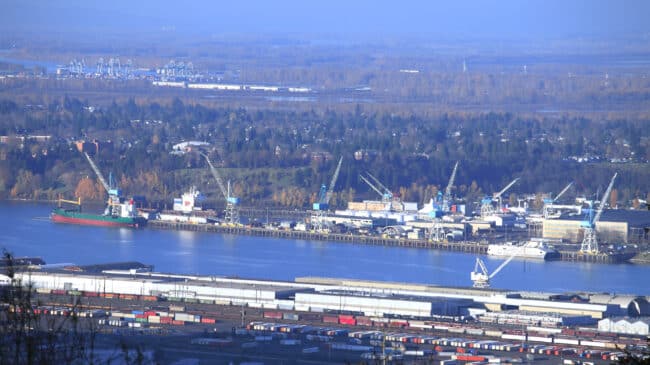The recent agreement for Harbor Industrial, a private port services company, to take over operations at Terminal 6 at the Port of Portland represents a significant step towards revitalizing Oregon’s only international container terminal.
However, this decision to pursue a limited operation and maintenance agreement with Harbor Industrial rather than a more comprehensive design-build-finance-operate-maintain (DBFOM) public-private partnership (P3) is a missed opportunity given the port’s goals for the terminal. A full-fledged public-private partnership expansion might have addressed the terminal’s challenges (such as low draft and a need for higher capacity and efficiency) more effectively and positioned it for greater long-term success.
Terminal 6 is Oregon’s only international container terminal and the only publicly operated international container terminal on the West Coast. The terminal’s operations are vital for the state’s agricultural, seafood, and retail industries, providing a direct trade link to Asia and other global markets. The port handles 40% of Oregon’s agricultural exports each year.
One of the primary challenges for the Port of Portland and Terminal 6 is its location. Situated approximately 100 miles from the Pacific Ocean next to the Columbia River, the terminal is at a disadvantage compared to other West Coast ports like Los Angeles and Seattle, which are closer to the ocean and have larger consumer markets. This distance increases transit times and costs, making it less attractive for shipping lines and importers.
Geographically, major complications come from that 100-mile stretch. The Columbia River provides access to Terminal 6, but has limited depth, restricting the size of vessels that can navigate to the terminal. This is a significant barrier, as the global shipping industry increasingly relies on larger ships to achieve economies of scale. Maintenance dredging is required to maintain the channel depth, but this is a costly and ongoing challenge, often requiring federal and state subsidies—especially when it would be necessary to maintain a deep depth for containerships that can require drafts of 50 feet.
Terminal 6 has faced substantial financial difficulties, particularly after the 2017 departure of International Container Terminal Services, Inc (ICTSI), the previous terminal operator. Traffic has declined over the last decade, largely due to labor issues that arose as part of an inter-union rivalry over positions at the port.
During the COVID-19 pandemic, when ship traffic was congested, the port poorly managed what traffic it did receive, thanks to still-ongoing labor disputes. ICTSI’s exit was precipitated by these prolonged labor disputes, which severely disrupted operations and led to a significant loss of business.
Though the union infighting has been resolved, traffic to the port still hasn’t returned. The Port of Portland incurred $14 million in losses from container operations over the past year.
The port’s newest agreement with Harbor Industrial is looking to change things for the better at the terminal. The agreement includes a $20 million state investment in capital improvements, such as pavement upgrades and stormwater management. While this partnership brings much-needed operational expertise and efficiency, it may not be enough to solve the port’s geographic problems or to revitalize Terminal 6’s traffic—a major goal of the plan outlined for Terminal 6.
A DBFOM P3 could have provided a more holistic solution to the challenges facing Terminal 6, especially given the ambitions laid out in the port’s business plan for the terminal. The Terminal 6 business plan includes:
- Doubling terminal container volumes by 2032 (up to 120,000 containers/year), then 180,000 containers/year after 2032.
- A shift from a tiered fee structure to a flat per-container fee structure.
- A 2% increase in productivity (measured by increasing moves per crane hour and vessel productivity)
While a limited-scope P3 could address and work on multiple improvements across the port, Terminal 6 is a critical asset in need of modernization and efficiency improvements.
A DBFOM P3 would involve a private partner in designing and building new infrastructure, not just maintaining existing facilities. This could include deepening the access channel (not the whole of the Columbia River) to accommodate larger vessels (similar to a berth extension P3 in the Port of Baltimore, Md.), expanding terminal capacity, and upgrading technology and equipment to improve efficiency.
P3s have been used at ports around the world and in the U.S., ranging from the Seagirt Marine Terminal Berth modernization project in Baltimore, Md., to the construction and operation of a new terminal in Edgemoor, Del. Dana Point Harbor in California’s revitalization P3 is also a good model—the P3 reached financial close in 2018 and involved reconstruction of harbor assets and refurbishment. The winning consortium will operate and maintain the harbor for 66 years.
Additionally, a design-build-finance-operate-maintain P3 would allow for better risk-sharing between the public and private sectors. The private partner would take on more of the financial and operational risks, incentivizing them to ensure the project’s success.
The main concern with a P3 approach in this case would be finding private-sector interest, given the Port of Portland’s troubled history. A guaranteed revenue stream through an availability payment P3 (paid to the private partner through either the port itself or by the state) may be necessary, but given the state’s willingness to invest in the terminal and operate it at a loss for the greater part of a year that doesn’t seem to be politically unfeasible.
While the operations and maintenance agreement with Harbor Industrial is a positive step towards improving Terminal 6’s operations, it represents a missed opportunity to fully address the terminal’s challenges through a more comprehensive design-build-finance-operate-maintain P3. By not committing to a full-fledged public-private partnership expansion, the Port of Portland and the port authority may have limited the potential for long-term growth. A DBFOM P3 could have provided the necessary investment, infrastructure development, and risk mitigation to ensure the terminal’s success and enhance its already critical role in Oregon’s economy.

